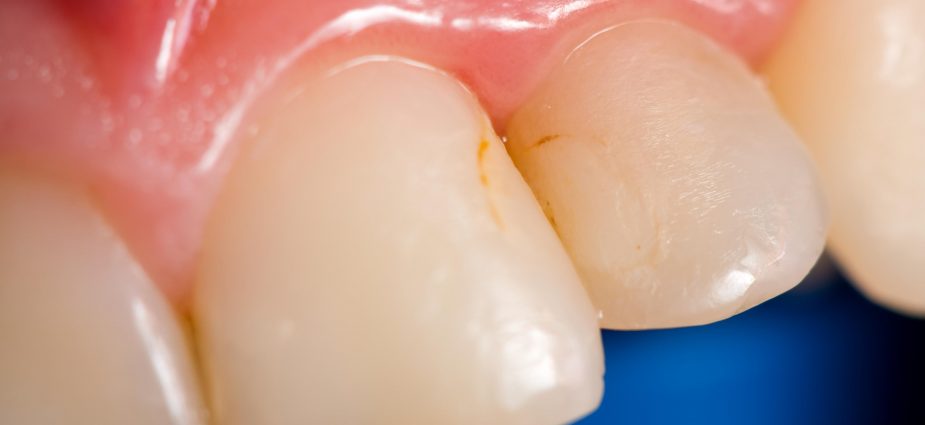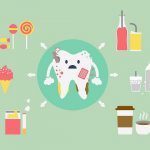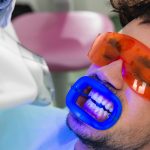Tooth Discoloration: Causes and Treatment of Stained Teeth
Medically Reviewed by: Thomas E. Dudney, DMD

In today’s appearance and youth-conscious society, the dull, stained effects of tooth discoloration represent a common dental complaint. Beyond the professionally managed teeth whitening options like Britesmile, Opalescence and Zoom whitening, people are employing new, everyday products in their ongoing struggle against yellow teeth and other forms of discoloration. From whitening strips and take-home trays to whitening toothpaste and chewing gum, people are going to various lengths to achieve and maintain a white, attractive smile.
Types of Discoloration
Tooth discoloration falls into two main types: extrinsic and intrinsic.
- Extrinsic discoloration occurs in the outer layer of the tooth, called the enamel; enamel stains can range from white streaks to yellow tints or brown spots and pits.
- Intrinsic discoloration occurs in the inner structure of the tooth, called the dentin, when the dentin darkens or displays a yellow (or gray) tint.
Whereas extrinsic staining can be effectively treated using various whitening techniques, intrinsic staining may be more stubborn, potentially requiring alternative cosmetic treatment such as veneers.
Teeth Whitening vs Dental Veneers
Whitening and veneers are two popular smile makeover treatment options. Weigh their pros and cons with your needs.
What Causes Discoloration?
In order to effectively manage tooth discoloration, it is important to recognize the causes. These include:
- Foods/Drinks: Coffee, tea, colas, wines and certain foods (e.g., potatoes, cherries, blueberries) can cause extrinsic tooth stains.
- Tobacco Use: Smoking or chewing tobacco can result in discolored teeth.
- Poor Dental Hygiene: Inadequate brushing and flossing to remove plaque and stain-producing substances can cause tooth stains.
- Disease: Diseases affecting enamel and dentin can lead to tooth discoloration. Certain infections in pregnant mothers can cause discoloration in the baby by affecting enamel development.
- Medications: Antihistamines, antidepressants and high blood pressure drugs can discolor teeth. Maternal use of tetracycline antibiotics during the second half of pregnancy may result in discoloration of the baby’s tooth enamel. Children who take tetracycline and doxycycline antibiotics during permanent tooth development (before age eight) may experience intrinsic discoloration of the permanent teeth.
- Dental Work: Procedures requiring certain dental materials, such as silver amalgam restorations, can produce a grayish-black cast to teeth.
- Ageing: As you age, the outer layer of enamel on your teeth wears away, revealing the dentin’s natural, yellow color. Additionally, over the years your teeth accumulate more stains and tartars, causing them to darken and discolor.
- Genetics: Some lucky individuals have naturally brighter and/or thicker enamel than others.
- Environment: Excessive fluoride from environmental sources, such as high fluoride levels in drinking water, or from excessive use of fluoride applications, rinses, toothpastes and oral fluoride supplements, can cause discoloration.
- Medical Treatments: Certain treatments can adversely affect the color of enamel and dentin layers. For example, chemotherapy, and head and neck radiation are two such treatments.
- Trauma: A fall or any other injury that damages the nerves or chips/cracks the teeth can lead to discolored teeth in adults and children.
The Spectrum of Staining
The color of a tooth stain is influenced by what causes it. Factors that can cause tooth discoloration, and the type of stains they produce, include the following.
- Tetracycline Antibiotics: Tetracycline and other antibiotics causes stains that are generally blue-gray or yellow-brown in color, often in a horizontal striped pattern. Porcelain veneers are the treatment of choice for tetracycline-caused stains.
- Fluoride: Fluorosis, the overconsumption of fluoride during the tooth-forming years, frequently results in chalky white or brown spots, patches or lines on a tooth’s surface. Although brown stains respond well to bleaching, white stains remain unchanged, though the background may be lightened to make the white areas less noticeable. Occasionally, in order to address the problematic white areas, bleaching may need to be combined with bonded restorations or abrasion techniques. For example, enamel microabrasion, a treatment involving the rotary application of tooth-safe acid and super-fine, gritty paste, is used to remove superficial intrinsic discoloration caused by fluorosis and decalcifications resulting from orthodontic brackets or bands.
- Foods/Drinks & Tobacco: Coffee, tea, colas and red wine, when consumed over time, produce stains on teeth that can result in yellow, brown, green or orange discolorations. Typically, these types of tooth staining can be removed by regular professional cleanings and regular home dental care, which includes brushing, flossing and rinsing after meals, as well as by eliminating or cutting down on the stain-inducing foods and beverages. These types of stains also respond well to peroxide-based teeth whitening treatments; at-home whitening products such as whitening toothpastes, rinses, strips and gums may be recommended to help maintain and supplement in-office whitening procedures and treatments.
- Ageing: Over time, a person’s teeth will take on yellow or brown hues. In-office and at-home bleaching treatments will produce significant whitening effects. Periodic re-treatments are recommended for the best long-term results.
- Genetics: Like your complexion or the color of your eyes, your teeth may appear yellower, browner or grayer due to inherited genes. Teeth whitening treatments may have little or no noticeable effects on teeth that have natural discolorations. In such instances, your dentist may recommend the use of veneers or composites.
- Poor Oral Hygiene/Tooth Decay: These can cause your teeth to have stains that are white, gray, brown, yellow, or even black and green. Teeth whitening products will not resolve these types of stains. In such cases, the person’s dentist must repair the damage caused by the neglect and tooth decay with dental restorations, such as fillings, dental crowns, or veneers.
- Dental Restorations: Failed or deteriorating dental restorations can produce gray, brown, black, yellow or green stains. Additionally, it is normal that white fillings experience staining as time passes. Metal fillings, even if not directly visible, can show through translucent tooth structure. For example, blue, gray or black stains are often associated with restorations involving amalgam, glass ionomer or acrylic, and porcelain fused to metal crowns. Teeth whitening products will not change the color of existing dental work. In such cases, your dentist might recommend the placement of new dental restorations after the completion of teeth whitening procedures.
- Trauma/Root Canal Treatments: Traumatic events, such as an accident or a fall, as well as root canal treatments, can result in nerve tissue damage that can cause gray or brown tooth stains. Stains only form on the tooth or teeth directly affected by the incident. In some cases, this discoloration may be an indication that the nerve inside the tooth has died. While the use of a teeth whitening product may lighten the color of a nerve-dead tooth, it will not resolve the underlying problem, which should be treated to avoid the possibility of more severe pain and/or tooth problems. If your tooth has darkened after a root canal, bleaching the enamel won’t help. Your dentist can apply a bleaching material to the inside of the tooth, or suggest a crown or veneer. In cases when the tooth is chipped or badly damaged, your dentist may recommend covering it with a crown or veneer.
Treatments
Treatment options for discolored teeth vary depending on the cause. Before a custom treatment plan can be developed to combat discoloration, a comprehensive oral health evaluation must first be performed. Common problems such as tooth decay and gum disease will require treatment before esthetics can be considered.
Treatment options may include the following:
Good Hygiene: Practice proper dental hygiene by brushing and flossing daily, and getting professional teeth cleanings every six months or more frequently, depending on your dentist’s recommendation, to help remove surface stains and bacteria. Use an ultrasonic toothbrush, which more effectively removes stain-causing foods from tooth surfaces.
Composite Bonding, Crowns and Veneers: For teeth severely discolored by excessive fluoride, root canal treatment, or consumption of tetracycline or other drugs, your dentist may recommend covering the tooth’s outer surface with a color-matched composite bonding material, porcelain veneers or porcelain crowns instead of bleaching. Composite resin veneers, which cost about $250 per tooth, are applied directly to your teeth and sculpted in the desired shape and shade. Porcelain veneers, which are thin porcelain shells bonded over the front of your teeth, cost $900 to $2,500 per tooth. Lumineers, an alternative porcelain veneer made from Cerinate porcelain, cost $700 to $1,000 per tooth. Porcelain crowns, also called caps, average $600 to $3,100 per tooth.
Whitening Procedures: Tooth whitening procedures fall into four categories:
- In-office Tooth Whitening: Your dentist can easily remove extrinsic and some intrinsic tooth discoloration caused by foods/drinks and other causes by applying a bleaching peroxide gel to the tooth enamel. The process typically takes an hour and costs an average of $650 per visit. People with particularly stubborn staining may need to return for one or more additional whitening sessions, or be advised to continue with an at-home use whitening system provided by their dentist.(Read more about in-office whitening)
- Dentist-dispensed At-home Bleaching: Many dentists believe that professionally dispensed take-home whitening kits may produce the best results over time. More suitable for extrinsic tooth discoloration, home whitening usually is done with teeth whitening kits, gels or strips. Typically, a custom-fit or standard mouth tray and a whitening gel are used. The gel, which is a lower-concentration peroxide-based formulation of in-office versions, is put into the mouth trays and worn daily for an hour or longer (sometimes overnight) for about two to four weeks, depending on the desired shade. Take-home teeth whitening kits cost on average between $100 and $500.(Read more about at-home whitening)
- Consumer-purchased/Over-the-counter (OTC) for At-home Use: OTC whitening products offer a convenient and low-cost alternative to bleaching teeth without dentist supervision. Featuring a lower-concentration bleaching agent, OTC products — available in supermarkets, drug stores or through the Internet — include rinses, paint-on liquids, toothpastes, chewing gums, dental floss and whitening strips. Toothpastes, chewing gums and dental floss remove superficial stains. Rinses and paint-on brushes with low levels of hydrogen peroxide have some whitening effect; strips present similar esthetic results. Costs will range between $4 and $100.
- Other Non-dental Office Options: An emerging tooth whitening trend is the availability of whitening treatments or kits in retail venues such as mall kiosks, salons and spas, and even cruise ships and airports administered by non-dental professionals. Prices can range from around $99 in mall kiosks and airports to around $200 at salons, spas and cruise ships.
Consult with your dentist for the best treatment options for your individual case.
Prevention and Maintenance
Certain lifestyle choices can help prevent tooth discoloration, as well as keep your teeth white after whitening. For example, avoid stain-causing foods and beverages, as well as overexposure to fluoride. If you are a coffee drinker and/or smoker, quit or cut back. Rinse your mouth with water after having wine, coffee or other drinks/foods that can cause tooth stains. Intrinsic stains caused by damage to a nerve or blood vessel in a tooth may be prevented with root canal treatment to remove the inner part of the tooth, called the pulp, before it decays and darkens.
Additional Considerations
Bleaching is indicated primarily for patients with generalized yellow, orange or light brown extrinsic discoloration, including chlorhexidine staining. Bleaching also may be helpful in improving mild cases of tetracycline-induced intrinsic discoloration and fluorosis. In-office “power bleaching” involves the use of a light-activated 15 to 40 percent hydrogen peroxide solution and must be performed by a dental professional; at-home bleaching systems, which may be used alone or in combination with in-office bleaching, are less concentrated and produce gradual results over a longer period of time.
Whitening toothpastes, containing one percent or less peroxide, are minimally effective on milder discolorations. For darker stains, the best results are achieved by using a combination of in-office and at-home bleaching systems. Periodic re-treatments are also usually required.
Some extrinsic stains may be removed with ultrasonic cleaning, rotary polishing with an abrasive prophylactic paste or air-jet polishing with an abrasive powder. Keep in mind, though, that these methods can lead to enamel erosion, so their frequent use is not advised.
Consultation with and treatment by medical professionals may be required if the underlying cause of tooth discoloration is related to a systemic disease. Endodontists, prosthodontists, periodontists, and oral and maxillofacial surgeons may be needed to assist with therapies.
[updated March 27, 2019]
About the Reviewer

Thomas E. Dudney, DMD, is a highly experienced dentist offering an array of dental services through his Alabama-based practice, Alabaster Aesthetic Dentistry. A graduate of the University of Alabama in Birmingham School of Dentistry, Dr. Dudney has previously served as the Clinical Director for the Aesthetic Advantage hands-on programs taught by Dr. Larry Rosenthal at New York University and the Eastman Dental Clinic in London. He has also served as Clinical Director for the California Center for Advanced Dental Studies (CCADS) live patient hands-on programs and is currently the Clinical Director for Pacific Aesthetic Continuum (PAC) hands-on programs.
Dr. Dudney is a member of the American Dental Association, the Alabama Dental Association and the American Academy of Cosmetic Dentistry, and an accredited member of the American Society for Dental Aesthetics and a Diplomate of the American Board of Aesthetic Dentistry.








